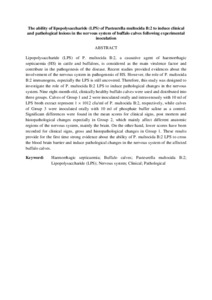Citation
Marza, Ali Dhiaa and Abdullah, Faez Firdaus Jesse and Ahmed, Ihsan Muneer and Lim, Eric Teik Chung and Ibrahim, Hayder Hamzah and Zamri-Saad, Mohd and Omar, Abdul Rahman and Bakar, Md Zuki Abu and Saharee, Abdul Aziz and Haron, Abdul Wahid and Alwan, Mohammed Jwaid and Lila, Mohd Azmi Mohd
(2017)
The ability of lipopolysaccharide (LPS) of Pasteurella multocida B:2 to induce clinical and pathological lesions in the nervous system of buffalo calves following experimental inoculation.
Microbial Pathogenesis, 104.
340 - 347.
ISSN 0882-4010; ESSN: 1096-1208
Abstract
Lipopolysaccharide (LPS) of P. multocida B:2, a causative agent of haemorrhagic septicaemia (HS) in cattle and buffaloes, is considered as the main virulence factor and contribute in the pathogenesis of the disease. Recent studies provided evidences about the involvement of the nervous system in pathogenesis of HS. However, the role of P. multocida B:2 immunogens, especially the LPS is still uncovered. Therefore, this study was designed to investigate the role of P. multocida B:2 LPS to induce pathological changes in the nervous system. Nine eight-month-old, clinically healthy buffalo calves were used and distributed into three groups. Calves of Group 1 and 2 were inoculated orally and intravenously with 10 ml of LPS broth extract represent 1 × 1012 cfu/ml of P. multocida B:2, respectively, while calves of Group 3 were inoculated orally with 10 ml of phosphate buffer saline as a control. Significant differences were found in the mean scores for clinical signs, post mortem and histopathological changes especially in Group 2, which mainly affect different anatomic regions of the nervous system, mainly the brain. On the other hand, lower scores have been recorded for clinical signs, gross and histopathological changes in Group 1. These results provide for the first time strong evidence about the ability of P. multocida B:2 LPS to cross the blood brain barrier and induce pathological changes in the nervous system of the affected buffalo calves.
Download File
![[img]](http://psasir.upm.edu.my/63398/1.hassmallThumbnailVersion/The%20ability%20of%20lipopolysaccharide%20%28LPS%29%20of%20Pasteurella%20multocida.pdf)  Preview |
|
Text (Abstract)
The ability of lipopolysaccharide (LPS) of Pasteurella multocida.pdf
Download (6kB)
| Preview
|
|
Additional Metadata
Actions (login required)
 |
View Item |

